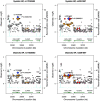Identification of the UBP1 locus as a critical blood pressure determinant using a combination of mouse and human genetics
- PMID: 19662162
- PMCID: PMC2715105
- DOI: 10.1371/journal.pgen.1000591
Identification of the UBP1 locus as a critical blood pressure determinant using a combination of mouse and human genetics
Abstract
Hypertension is a major health problem of largely unknown genetic origins. To identify new genes responsible for hypertension, genetic analysis of recombinant inbred strains of mice followed by human association studies might prove powerful and was exploited in our current study. Using a set of 27 recombinant BXD strains of mice we identified a quantitative trait locus (QTL) for blood pressure (BP) on distal chromosome 9. The association analysis of markers encompassing the syntenic region on human chromosome 3 gave in an additive genetic model the strongest association for rs17030583 C/T and rs2291897 G/A, located within the UBP1 locus, with systolic and diastolic BP (rs17030583: 1.3+/-0.4 mmHg p<0.001, 0.8+/-0.3 mmHg p = 0.006, respectively and rs2291897: 1.5+/-0.4 mmHg p<0.001, 0.8+/-0.3 mmHg p = 0.003, respectively) in three separate studies. Our study, which underscores the marked complementarities of mouse and human genetic approaches, identifies the UBP1 locus as a critical blood pressure determinant. UBP1 plays a role in cholesterol and steroid metabolism via the transcriptional activation of CYP11A, the rate-limiting enzyme in pregnenolone and aldosterone biosynthesis. We suggest that UBP1 and its functional partners are components of a network controlling blood pressure.
Conflict of interest statement
The authors have declared that no competing interests exist.
Figures



Similar articles
-
Gene by smoking interaction in hypertension: identification of a major quantitative trait locus on chromosome 15q for systolic blood pressure in Mexican-Americans.J Hypertens. 2009 Mar;27(3):491-501. doi: 10.1097/hjh.0b013e32831ef54f. J Hypertens. 2009. PMID: 19330903 Free PMC article.
-
Genome-Wide Association Study of Apparent Treatment-Resistant Hypertension in the CHARGE Consortium: The CHARGE Pharmacogenetics Working Group.Am J Hypertens. 2019 Nov 15;32(12):1146-1153. doi: 10.1093/ajh/hpz150. Am J Hypertens. 2019. PMID: 31545351 Free PMC article.
-
Genetic, physiological and comparative genomic studies of hypertension and insulin resistance in the spontaneously hypertensive rat.Dis Model Mech. 2017 Mar 1;10(3):297-306. doi: 10.1242/dmm.026716. Epub 2017 Jan 26. Dis Model Mech. 2017. PMID: 28130354 Free PMC article.
-
Sex-specific effects on spatial learning and memory, and sex-independent effects on blood pressure of a <3.3 Mbp rat chromosome 2 QTL region in Dahl salt-sensitive rats.PLoS One. 2013 Jul 4;8(7):e67673. doi: 10.1371/journal.pone.0067673. Print 2013. PLoS One. 2013. PMID: 23861781 Free PMC article.
-
ACTH and Polymorphisms at Steroidogenic Loci as Determinants of Aldosterone Secretion and Blood Pressure.Int J Mol Sci. 2017 Mar 7;18(3):579. doi: 10.3390/ijms18030579. Int J Mol Sci. 2017. PMID: 28272372 Free PMC article. Review.
Cited by
-
Weighted gene co-expression network analysis identifies key hub genes and pathways in acute myeloid leukemia.Front Genet. 2023 Feb 27;14:1009462. doi: 10.3389/fgene.2023.1009462. eCollection 2023. Front Genet. 2023. PMID: 36923792 Free PMC article.
-
Genetic, epigenetic, and gene-by-diet interaction effects underlie variation in serum lipids in a LG/JxSM/J murine model.J Lipid Res. 2010 Oct;51(10):2976-84. doi: 10.1194/jlr.M006957. Epub 2010 Jul 2. J Lipid Res. 2010. PMID: 20601649 Free PMC article.
-
The Convergence of Systems and Reductionist Approaches in Complex Trait Analysis.Cell. 2015 Jul 2;162(1):23-32. doi: 10.1016/j.cell.2015.06.024. Cell. 2015. PMID: 26140590 Free PMC article. Review.
-
Absence of TI-VAMP/Vamp7 leads to increased anxiety in mice.J Neurosci. 2012 Feb 8;32(6):1962-8. doi: 10.1523/JNEUROSCI.4436-11.2012. J Neurosci. 2012. PMID: 22323709 Free PMC article.
-
Reproducibility and replicability of rodent phenotyping in preclinical studies.Neurosci Biobehav Rev. 2018 Apr;87:218-232. doi: 10.1016/j.neubiorev.2018.01.003. Epub 2018 Jan 31. Neurosci Biobehav Rev. 2018. PMID: 29357292 Free PMC article. Review.
References
-
- Lloyd-Jones D, Adams R, Carnethon M, De Simone G, Ferguson TB, et al. Heart disease and stroke statistics—2009 update: a report from the American Heart Association Statistics Committee and Stroke Statistics Subcommittee. Circulation. 2009;119:e21–181. - PubMed
-
- Lawes CM, Vander Hoorn S, Law MR, Elliott P, MacMahon S, et al. Blood pressure and the global burden of disease 2000. Part II: estimates of attributable burden. J Hypertens. 2006;24:423–430. - PubMed
-
- Lifton RP, Gharavi AG, Geller DS. Molecular mechanisms of human hypertension. Cell. 2001;104:545–556. - PubMed
-
- Mune T, Rogerson FM, Nikkila H, Agarwal AK, White PC. Human hypertension caused by mutations in the kidney isozyme of 11 beta-hydroxysteroid dehydrogenase. Nat Genet. 1995;10:394–399. - PubMed
-
- Lifton RP, Dluhy RG, Powers M, Rich GM, Cook S, et al. A chimaeric 11 beta-hydroxylase/aldosterone synthase gene causes glucocorticoid-remediable aldosteronism and human hypertension. Nature. 1992;355:262–265. - PubMed
Publication types
MeSH terms
Substances
Grants and funding
LinkOut - more resources
Full Text Sources
Medical
Molecular Biology Databases

